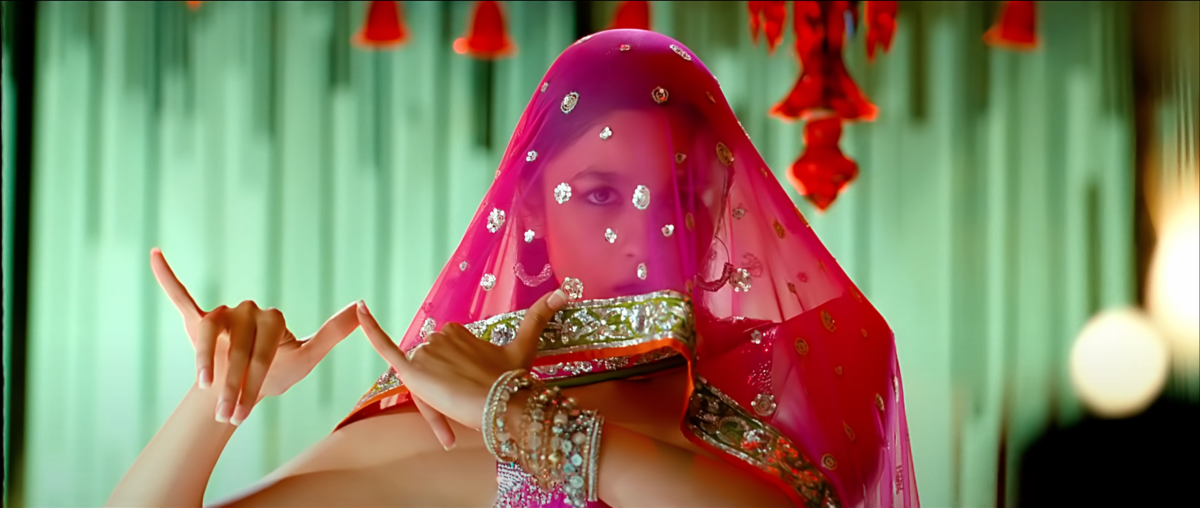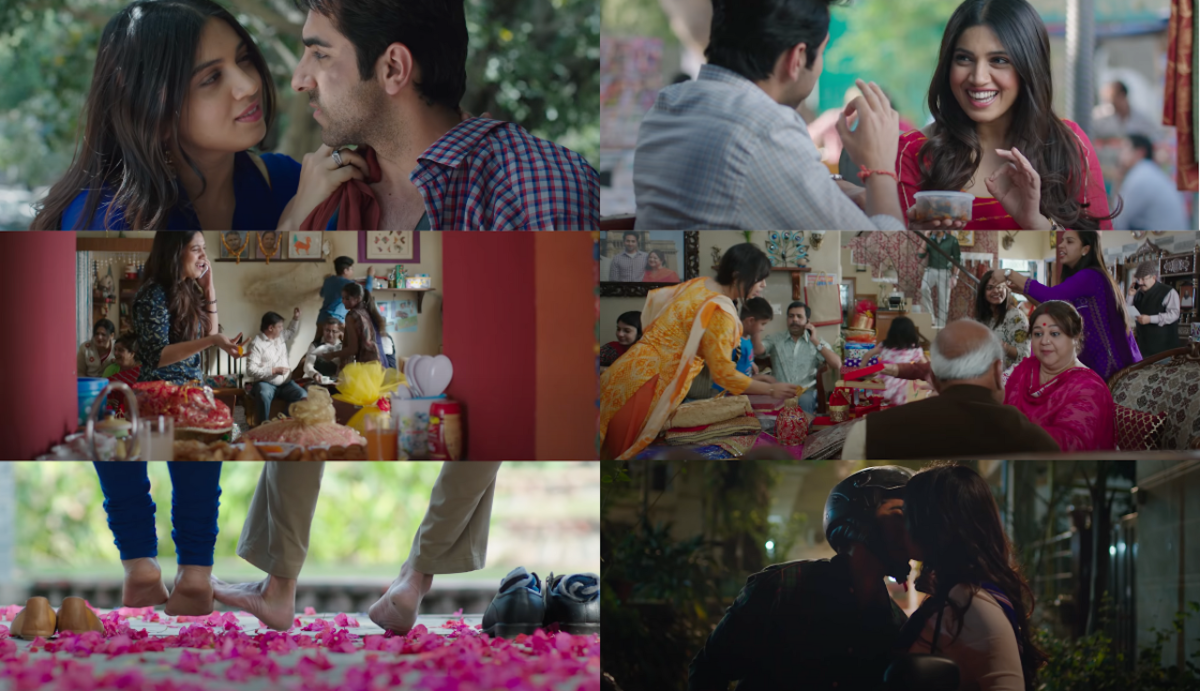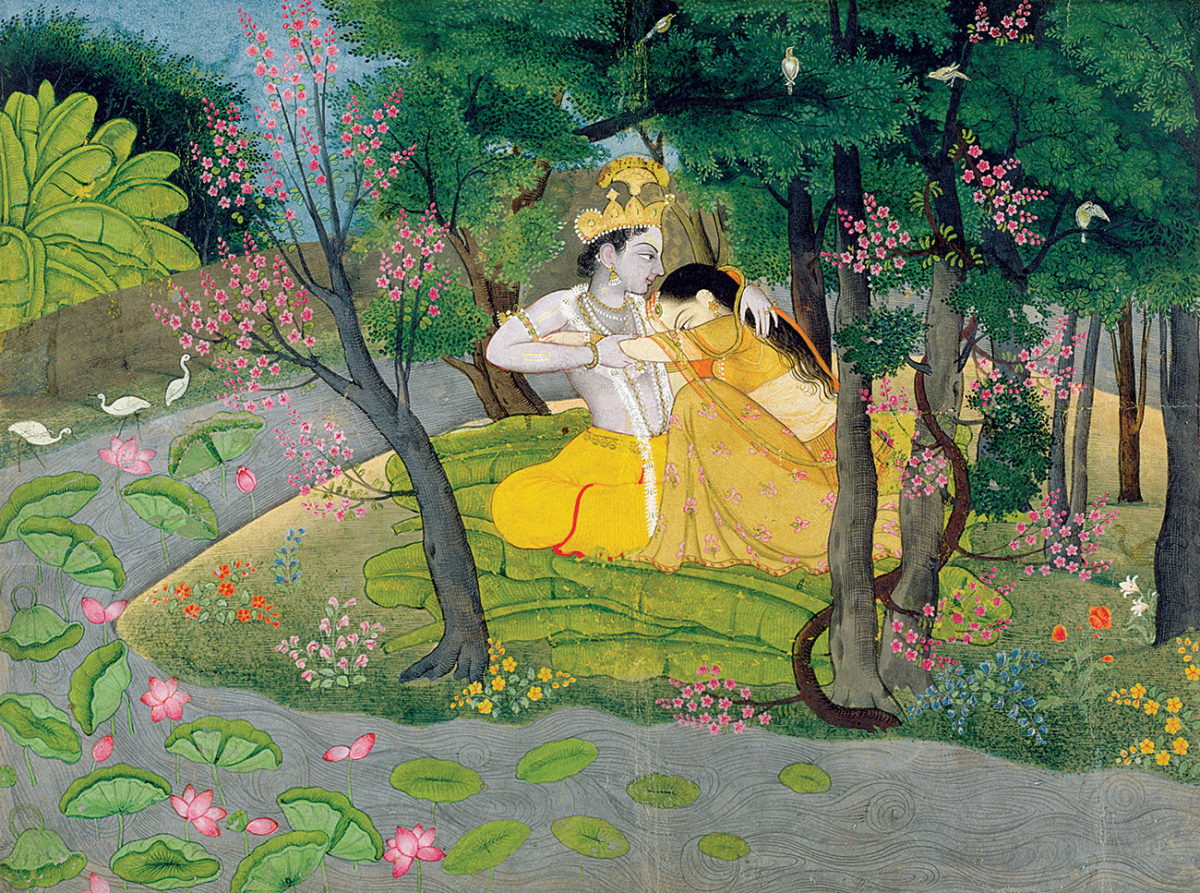Tradition is participation. Raymond Williams observed that this concept involves “selection and reselection”, born not out of necessity, but desire.Williams, Raymond. Culture. Glasgow: Fontana Press, 1981: 187. Cinema, an industry with an infantile tradition of its own, has roots in several other traditions: literature, drama, music, and the visual arts. Its history goes beyond itself, and the films we see today are, in this way, much older than we think. Cinema becomes tradition itself, traditional and inventive simultaneously. Consequently, traditions within cinema are by no means static or simplistic; they are living creatures, growing and developing. But sometimes stagnation creeps into a cinematic trope, turning it into a corpse. The ‘Radha-Krishna’, which represents ideal romantic love through analogies with two theological figures, is one such monolith. Since being adopted into Hindi cinema’s musicology, it has barely been modified; it remains pervasive in its facsimile repetitions. This means that the most problematic aspects of the Radha-Krishna trope have seeped into contemporary cinema; its musicology is finally starting to reek of this ‘traditional’ corpse, creating the ‘Radha-Problem.’
The mythical Radha-Krishna became a literary trope during the Bhakti Movement, a religious recontextualisation of mediaeval Hinduism. Regular use in bhajans and Sufi compositions ensured that this trope dominated theological ideologies. The coupling was principally religious; Krishna was a god and Radha, his worshipper. The relationship was devotional to such an extent that Radha was seen not as a female lover but a genderless devotee.See Frazier, Jessica. ‘Becoming the Goddess: Female Subjectivity and the Passion of the Goddess Radha’. In New Topics in Feminist Philosophy of Religion. Springer, Dordrecht, 2009: 199-215. This trope dissolved into popular thought and culture, where it continues to thrive as the highest form of male-female romantic love. And when it percolated into the language of Hindi cinema, the trope’s religio-spiritual meaning disappeared.
The trope lent itself to cinema’s musicology and became a staple in what Sarrazin calls romantic ‘public’ songs, their context being social (festivals, weddings, mehfils, etc.).Sarrazin, Natalie. ‘Celluloid Love Songs: Musical ‘Modus Operandi’ and the Dramatic Aesthetics of Romantic Hindi Film’. Popular Music 27, no. 3 (2008): 398-401 In the trope, the male-hero dons the role of Krishna and the female-heroine becomes Radha. All of the songs utilising this trope employ either one or both of the following episodes: ‘butter theft’ (Krishna is notorious for stealing butter) and panghata-lila (which literally means to ‘play at the steps-leading-to-a-body-of-water’, referring to the eve-teasing and casual harassment of women on the road to or from a source of water). It is not difficult to see the erotic connotations. These herdswomen collect and complain to Krishna’s mother, Mother Yashoda, but their complaints are hollow and insincere, because they have secretly enjoyed being harassed. Music is an irreplaceable part of Hindi Cinema and the percolation of the Radha-Krishna trope reflects on the larger cinematic thought of this tradition and industry. These songs are either a catalogue of mock complaints, performed by courtesans or the female-lead, addressing Mother Yashoda or Krishna. The Radha-heroine’s complaints are always artificial, only clear in her expressions and body language, creating a serious gap between the vocal and the visual. The Krishna-hero gets away with harassment and his actions are celebrated as heroic passion, overwhelming the accoster and lover. Pauwels, an expert in Hinduism and its reception, has observed that because our sympathies lie with the hero, he is allowed such behaviour.See Pauwels, Heidi RM. The Goddess as Role Model: Sita and Radha in Scripture and on Screen. Oxford University Press, 2008. (esp. Ch. 6) As far as the Radha-heroine goes, her ‘yes’ means ‘no’ and in her, the victim and beloved become synonymous. Furthermore, her only expression of desire is in its denial.See Pauwels, Heidi. ‘”The Woman Waylaid at the Well” or Paṇaghaṭa-Līlā: An Indian Folk Theme Appropriated in Myth and Movies’. Asian Ethnology 69, no. 1 (2010): 1–33. She is even blamed for her own harassment. Cinematic love becomes something inherently violent and coercive, so cramped with male desire that there is no space left for female subjectification of desire. This is the Radha-Problem.
Hindi cinema has incessantly (ab)used this mythological trope and put forward an ossified idea of love: gendered and problematic. Barring a few rare experiments (Mother India, 1957; Barsaat ki Raat, 1960), this trope has been remade again and again at the peripheries of the same politics.Ibid. But in the last ten years or so, filmmakers and lyricists have dared to challenge the convention. I discuss three films that address the Radha-Problem and try to resolve it through a similar pattern. Addressing the Radha-problem in its cinematic trope requires that the gap between the vocal and visual be closed or manipulated; it requires all or a combination of these five interventions: role-reversal; bestowing new meanings on images (ras-lila, the Road, butter, etc.); an independent Radha or a democratic Radha-Krishna; Radha as an expressive subject of her desire; and lastly, a re-contextualisation of the song in the film’s narrative. Creatively engaging with the Radha-Problem, the following three songs mark a radical departure from the usual imitations of the Radha-Krishna trope. In a way, they remake the trope.

‘Radha’, from Karan Johar’s Student of the Year (2012), is a good starting point. The context of the song is familiar: a wedding. ‘Radha’ constructs, through costume and choreography, the Radha-heroine (Alia Bhatt) as a 21st century young woman who likes to dance and party. This introduction is rebellious because in the Radha-Krishna trope, dance (ras-lila) has always centred around Krishna. Here, the Radha-heroine dominates the screen-space and dance-performance while the Krishna-hero stands as a passive viewer. She describes episodes of harassment and how she is the one blamed for Krishna’s actions. In the second verse, she commits borderline blasphemy by rejecting the Krishna-hero (Varun Dhawan). In the larger plot of the film, Bhatt rejects Dhawan and ends up with Sidharth Malhotra’s character. But there are limits to this song’s unorthodox attitudes. The Krishna-hero is brought in with the third verse and he takes ownership of the Radha-heroine’s very existence, through the lyrics and his screen presence; he has a strong choreographic solo and Radha’s girlfriends are now shown as Krishna’s admirers. ‘Radha’ begins with a Radha-heroine who is independent of the Krishna-hero, even subverting the ras-lila theme. She addresses harassment and victim blaming, dismisses Krishna, and takes on his playboy role. She expresses her desire, freely and free of Krishna. But while she is admonished for her desire, the Krishna-hero’s desire is celebrated for his philandering. The male voice in the song begins to control the gaze, objectifies and infantilises the Radha-heroine, and ultimately has narrative control. Still, the radical potential of ‘Radha’ is not completely lost, because the female voice earnestly and unflinchingly engages with the Radha-Problem and is victorious, however ephemeral that victory might be. Radha’s complaints are not hollow and through camera placements, choreography and facial expressions, the distance between the female voice and female visuals is reduced.
Two years before ‘Radha’, in 2010, the Hindi film industry produced ‘Maiyya Yashoda’ in Abbas Tyrewala’s Jhootha Hi Sahi. The context is again a wedding but the song has an unusual approach to desire. Written as a mock complaint to Mother Yashoda (like ‘Maiya Yashoda’ Hum Saath Saath Hain, 1999), it contains a conventional set of images but spends its time redefining them. It is notable that the prelude, a short list of complaints regarding panghata-lila, is performed not by the Radha-heroine (Pakhi Tyrewala) but the Krishna-hero (John Abraham), and she is alleged as the perpetrator. She herself enacts some scenes from the panghata-lila as Krishna: twisting the Krishna-hero’s arm, breaking pots, etc. She begins her verse with the usual butter-theft problems, but it is important to note that the breaking of the pot is equated to being freed of a burden. Furthermore, every actor on screen, male and female, pretends to hold a pot on their head while dancing, a visual challenge to the trope. Paying close attention to the gendering of the singing voice, it becomes clear that this song aims to transgress: opening verses are sung collectively, lines traditionally belonging to the female voice are given to the male voice, and the female voice has ultimate control over the song, narrative and performance.
The Krishna-hero responds to the theft allegation by saying that he actually went to save the butter, that he found an upset Radha-heroine, and encouraged her to taste the butter. He ends by stating that the two of them sat together and finished all the butter. The female voice takes over and tells the story from the Radha-heroine’s side: she used to cry and be scared of the butter-thief before the Krishna-hero made her realise that she is strong and should enjoy the butter herself. She ends by saying that she actually invited the Krishna-hero to share the butter and thus made him hers. The central idea of this song is slowly revealed to be the Krishna-hero helping the Radha-heroine overcome grief and fear. Making references to the film’s narrative, the song has two butter-thieves: the good butter-thief (the Krishna-hero) and the bad butter-thief (the abusive ex-boyfriend). When the Radha-heroine gets her confidence back, she vocalises her desire with authority. Here, the Krishna-hero doesn’t stop and harass the Radha-heroine, but the Radha-heroine herself initiates the romance. Her desire is possessive and she proclaims ownership of him. The song conceptualises desire as democratic and egalitarian, as the two share the butter. The song overturns gender dynamics by reversing Radha-Krishna roles through choreography, framing and the assignment of verses to male and female voices. The gap between visual and vocal is not closed but made non-existent by an extensive blurring of binaries.

The third and final song is the very recent ‘Kanha’ from R. S. Prasanna’s Shubh Mangal Saavdhan (2017). ‘Kanha’ has a complex context. It is more personal than public, playing over a montage of romantic domestic scenes, a couple soon to marry. But it is not simply a disposable love-ballad. Because it is sung entirely in the female voice, the song is reminiscent of courtesan songs, wherein tawaifs use mock complaints to seduce a male audience. But here, by personalising the song through domestic visuals, the female (courtesan) voice, and thus, desire, are given new meaning; ‘Kanha’ does not entertain a salacious male viewership but foreshadows events that follow and set the premise for the film. The Krishna-hero (Ayushmann Khurrana), suffers from erectile-dysfunction, rendering male desire dysfunctional. The Radha-heroine (Bhumi Pednekar) opens the song by listing all the things that the Krishna-hero easily conquers by himself, with one phallic exception. In saying: ‘The road to the river/well is arduous, but Kanha doesn’t listen’, she turns panghata-lila on its head. By warning the Krishna-hero that the Road is difficult, she turns him into her Radha (the road, traditionally the site for male desire to exert itself, here alludes to the erectile issue). This line completely changes the umbrella meaning of the song. In the second verse, the traditional images are accounts of the Krishna-hero’s attitude towards his problem and the Radha-heroine’s efforts in supporting him deal with the problem. This nods to the way Khurrana’s character behaves in the film, rejecting Pednekar’s help at every turn. The hook of ‘Kanha’ is ‘Kanha doesn’t listen.’ The last pre-chorus is the Radha-heroine addressing the Krishna-hero’s impatience and arrogance. ‘Kanha’ uses the same-old images without any changes but manages to skillfully challenge them by changing the context. The context is altered to such an extent that the traditionally overpowering presence of male desire is disposed of completely (remember, the Krishna-hero has a faulty penis) and replaced with female subjectivity, prudence and affection. The Krishna-hero becomes Radha walking the dangerous Road and the Radha-heroine is the voice of wisdom and reason, offering to accompany the Krishna-hero-turned-Radha on the Road as a guardian. ‘Kanha’ plucks out (male) desire from the Radha-Krishna trope and replaces it with female patience and sagacity. The visual-vocal gap of the trope is not reduced but increased in such a way that it draws attention to itself; the song exposes problematic gendered expressions of desire by deviating from its ancestry of courtesan songs and getting rid of male desire altogether.
These Radhas are not cinema’s usual Radhas. They are bold and confident in expressing their desires and questioning their Krishnas. Through them, the Radha-Krishna trope is challenged, changed and remade. This resolution of the Radha-problem is not a rebellion against the Radha-Krishna trope, but a rebellion within the trope. It is inventing tradition, and what is tradition if not invention? Carrying around the cadaver of this trope has been the conscious choice of filmmakers, choreographers, cinematographers, composers and lyricists. These three cinematic-songs also make a choice: to rejuvenate the corpse of the trope. Cinema is both tradition as well as a creator of traditions, which puts it in the unique position of being able to bring out the “great labour” involved in tradition.Eliot, T. S. ‘Tradition and Individual Talent’. The Sacred Wood. London: Methuen and Co. 1969: 49 It has the potential to expose how much of tradition is actually active (re)construction and not passive reception. Bharucha argues that tradition is like language, it has to acquire new words.Bharucha, Rustom. ‘Notes on the Invention of Tradition’. Economic and Political Weekly 24, no. 33 (1989): 1911 These songs are just continued-beginnings. The Radha-Krishna trope will live on in Hindi Cinema’s musicology, not despite, but because of all its mutations and metamorphoses. Meaning, both within and without cinema, is not predetermined, it is (re)made, and change is its essence.
